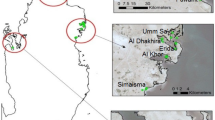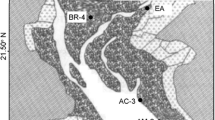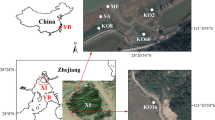Abstract
Afforestation is a primary response to the loss and degradation of mangroves worldwide. The successful restoration of mangrove ecosystems is in part indicated by the rebuilding of macrobenthic community. However, the community dynamic of benthic macrofauna after mangrove afforestation was poorly known. Here, three quarterly surveys (2006–2007, 2014–2015, 2019–2020) of the benthic macrofauna and sediment grain size were conducted in a mix-planted mangrove stand (Kandelia obovata + Sonneratia apetala) in Xiamen Tong’an Bay, China. Our results showed that the community structure of benthic macrofauna differed significantly after mangrove afforestation. These differences were accompanied by the declines in the species number, abundance, biomass, and diversity (H’), as well as the fining of sediments. We also found that the epifauna and infauna exhibited different adaptabilities to mangrove vegetation. Additionally, shifts in the composition of the functional feeding groups were observed, indicating the modification of trophic structure after mangrove afforestation. We recommend that future mangrove afforestation programs call for a guide to coordinate habitats for different taxa.
Graphic Abstract






Similar content being viewed by others
Data Availability
Not applicable.
Code Availability
Not applicable.
References
Alongi DM (2002) Present state and future of the world’s mangrove forests. Environmental Conservation 29:331–349
Alongi DM (2008) Mangrove forests: resilience, protection from tsunamis, and responses to global climate change. Estuarine, Coastal and Shelf Science 76:1–13
Bird ECF (1971) Mangroves as land-builders. Victorian Naturalist 88:189–197
Bosire JO, Dahdouhguebas F, Walton M, Crona B, Lewis RR, Field CD, Kairo JG, Koedam N (2008) Functionality of restored mangroves: A review. Aquatic Botany 89:251–259
Cannicci S, Burrows D, Fratini S, Smith TJ, Offenberg J, Dahdouhguebas F (2008) Faunal impact on vegetation structure and ecosystem function in mangrove forests: A review. Aquatic Botany 89:186–200
Chen G, Ye Y (2008) Leaf consumption by Sesarma plicata in a mangrove forest at Jiulongjiang Estuary, China. Marine Biology 154:997–1007
Chen G, Ye Y, Lu C (2007) Changes of macro-benthic faunal community with stand age of rehabilitated Kandelia candel mangrove in Jiulongjiang Estuary, China. Ecological Engineering 31:215–224
Chen X, Cai L, Zhou X, Rao Y (2017) Geographical variation in oligochaete density and biomass in subtropical mangrove wetlands of China. Journal of Ocean University of China 16:925–931
Chen Q, Zhao Q, Chen P, Lu H, Jian S (2018a) Eco-exergy based self-organization of the macrobenthic faunal assemblage during mangrove succession in Zhanjiang, China. Ecological Indicators 95:887–894
Chen Q, Zhao Q, Jian S, Chen P (2018b) Changes in the functional feeding groups of macrobenthic fauna during mangrove forest succession in Zhanjiang, China. Ecological Research 33:959–970
Duke NC, Meynecke JO, Dittmann S, Ellison AM, Anger K, Berger U, Cannicci S, Diele K, Ewel KC, Field CD (2007) A world without mangroves? Science 317:41–42
Ellison AM (2000) Mangrove restoration: Do we know enough? Restoration Ecology 8:219–229
Evin LA, Talley TS (2002) Influences of vegetation and abiotic environmental factors on salt marsh invertebrates. Concepts and controversies in tidal marsh ecology. Springer, Dordrecht, pp 661–707
Ewel KC, Twilley RR, Ong JE (1998) Different kinds of mangrove forests provide different goods and services. Global Ecology Biogeography Letters 7:83–94
Feng J, Guo J, Huang Q, Jiang J, Huang G, Yang Z, Lin G (2014) Changes in the community structure and diet of benthic macrofauna in invasive Spartina alterniflora wetlands following restoration with native mangroves. Wetlands 34:673–683
Feng J, Huang Q, Chen H, Guo J, Lin G (2018) Restoration of native mangrove wetlands can reverse diet shifts of benthic macrofauna caused by invasive cordgrass. Journal of Applied Ecology 55:905–916
Field C (1999) Rehabilitation of mangrove ecosystems: an overview. Marine Pollution Bulletin 37:383–392
Giarrizzo T, Schwamborn R, Saintpaul U (2011) Utilization of carbon sources in a northern Brazilian mangrove ecosystem. Estuarine Coastal Shelf Science 95:447–457
Jumars PA, Dorgan KM, Lindsay SM (2015) Diet of worms emended: an update of polychaete feeding guilds. Annual Review of Marine Science 7:497–520
Khayat JAA, Abdulla MA, Alatalo JM (2019) Diversity of benthic macrofauna and physical parameters of sediments in natural mangroves and in afforested mangroves three decades after compensatory planting. Aquatic Sciences 81:1–11
Kon K, Kurokura H, Tongnunui P (2010) Effects of the physical structure of mangrove vegetation on a benthic faunal community. Journal of Experimental Marine Biology and Ecology 383:171–180
Koo BJ, Kim S, Hyun J (2019) Feeding behavior of the ocypodid crab Macrophthalmus japonicus and its effects on oxygen-penetration depth and organic-matter removal in intertidal sediments. Estuarine Coastal Shelf Science 228:106366
Kristensen E, Bouillon S, Dittmar T, Marchand C (2008) Organic carbon dynamics in mangrove ecosystems: a review. Aquatic Botany 89:201–219
Lana PDC, Guiss C (1991) Influence of Spartina alterniflora on structure and temporal variability of macrobenthic associations in a tidal flat of Paranagua Bay (southeastern Brazil). Marine Ecology Progress Series 73:231–244
Lee SY (2008) Mangrove macrobenthos: assemblages, services and linkages. Journal of Sea Research 59:16–29
Leung JYS (2015) Habitat heterogeneity determining the macrobenthic infaunal community in a mangrove swamp in South China: implication for plantation and plant invasion. J Coastal Res 313:624–633
Leung JY, Cheung NK (2017) Can mangrove plantation enhance the functional diversity of macrobenthic community in polluted mangroves? Marine Pollution Bulletin 116:454–461
Lewis RR (1984) Creation and restoration of coastal plant communities. CRC Press, Boca Raton
Lewis RR (2005) Ecological engineering for successful management and restoration of mangrove forests. Ecological Engineering 24:403–418
Li YF, Du FY, Gu YG, Ning JJ, Wang LG (2017) Changes of the macrobenthic faunal community with stand age of a non-native mangrove species in Futian Mangrove National Nature Reserve, Guangdong, China. Zoological Studies 56:1–14
Macdonald TA, Burd B, Macdonald V, Van Roodselaar A (2010) Taxonomic and feeding guild classification for the marine benthic macroinvertebrates of the Strait of Georgia, British Columbia. Fisheries and Oceans Canada, Pêches et océans Canada
Macintosh D, Ashton E, Havanon S (2002) Mangrove rehabilitation and intertidal biodiversity: a study in the Ranong mangrove ecosystem, Thailand. Estuarine, Coastal and Shelf Science 55:331–345
Morrisey D, Skilleter G, Ellis J, Burns B, Kemp C, Burt K (2003) Differences in benthic fauna and sediment among mangrove (Avicennia marina var. australasica) stands of different ages in New Zealand. Estuarine, Coastal and Shelf Science 56:581–592
Nagelkerken I, Blaber SJM, Bouillon S, Green P, Haywood M, Kirton LG, Meynecke J, Pawlik JR, Penrose HM, Sasekumar A (2008) The habitat function of mangroves for terrestrial and marine fauna: A review. Aquatic Botany 89:155–185
Pagliosa PR, Oortman MS, Rovai AS, Soriano-Sierra EJ (2016) Is mangrove planting insufficient for benthic macrofaunal recovery when environmental stress is persistent? Ecological Engineering 95:290–301
Peterson CH, Summerson HC, Duncan PB (1984) The influence of seagrass cover on population structure and individual growth rate of a suspension-feeding bivalve, Mercenaria mercenaria. Journal of Marine Research 42:123–138
Puryono S, Suryanti S (2019) Gastropod Diversity in mangrove forests of Mojo Village, Ulujami District, Pemalang Regency, Indonesia. Journal of Ecological Engineering 20:165–173
Ravichandran S, Kannupandi T, Kathiresan K (2006) Mangrove leaf litter processing by Sesarmid crabs. Ceylon Journal of Science (Biological Sciences) 35:107–114
Ryu J, Khim JS, Kang S, Kang D, Lee C, Koh C (2011) The impact of heavy metal pollution gradients in sediments on benthic macrofauna at population and community levels. Environmental Pollution 159:2622–2629
Skilleter GA, Warren S (2000) Effects of habitat modification in mangroves on the structure of mollusc and crab assemblages. Journal of Experimental Marine Biology and Ecology 244:107–129
Tang J, Ye S, Chen X, Yang H, Sun X, Wang F, Wen Q, Chen S (2018) Coastal blue carbon: Concept, study method, and the application to ecological restoration. Science China-earth Sciences 61:637–646
Walters BB, Ronnback P, Kovacs JM, Crona B, Hussain SA, Badola R, Primavera JH, Barbier EB, Dahdouhguebas F (2008) Ethnobiology, socio-economics and management of mangrove forests: A review. Aquatic Botany 89:220–236
Whitcraft CR, Levin LA (2007) Regulation of benthic algal and animal communities by salt marsh plants: impact of shading. Ecology 88:904–917
Acknowledgements
We sincerely appreciate the support of the Third Institute of Oceanography, Ministry of Natural Resources, in the analysis of sediment environmental data. We would like to thank Lulu Yan, Wenjun Li, Guoqiang Li, Jiali Zeng, Wenjuan Tan, Deyuan Yang and Binwen Chen for their support in sample collection. We are also grateful to Jingxiang Lin for his constructive comments as well as the reviewers for their helpful comments on the manuscript. All the members involved in this project are to be acknowledged here.
Funding
This work was funded by the National Key Research and Development Program of China [2017YFC0506101].
Author information
Authors and Affiliations
Contributions
Lizhe Cai conceived of the study and obtained funding. Lizhe Cai, Xiping Zhou, Sujing Fu, Xinwei Chen, Yiyong Rao, Wenqing Chen, and Bin Zheng were responsible for field and laboratory work. Lizhe Cai conducted the identification of benthic macrofauna and created many of the manuscript elements. Yiyong Rao led the data analysis and writing effort, with significant contributions to these by all authors.
Corresponding author
Ethics declarations
Ethics Approval
Not applicable.
Consent to Participate
Not applicable.
Consent for Publication
The authors consent to this manuscript’s publication.
Conflicts of Interest/Competing Interests
The authors declared that they have no conflicts of interest to this work.
Additional information
Publisher’s Note
Springer Nature remains neutral with regard to jurisdictional claims in published maps and institutional affiliations.
This article belongs to the Topical Collection: Wetland Animals.
Supplementary Information
ESM 1
(DOCX 169 kb)
Rights and permissions
About this article
Cite this article
Rao, Y., Cai, L., Zhou, X. et al. Changes of Community Structure and Functional Feeding Groups of Benthic Macrofauna After Mangrove Afforestation in a Subtropical Intertidal Zone, China. Wetlands 41, 114 (2021). https://doi.org/10.1007/s13157-021-01489-4
Received:
Accepted:
Published:
DOI: https://doi.org/10.1007/s13157-021-01489-4




